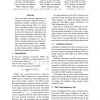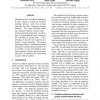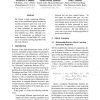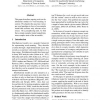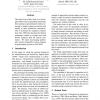ACL
2010
13 years 9 months ago
2010
This work deals with the application of confidence measures within an interactivepredictive machine translation system in order to reduce human effort. If a small loss in translat...
ACL
2010
13 years 9 months ago
2010
Many NLP tasks need accurate knowledge for semantic inference. To this end, mostly WordNet is utilized. Yet WordNet is limited, especially for inference between predicates. To hel...
ACL
2010
13 years 9 months ago
2010
Semi-supervised word alignment aims to improve the accuracy of automatic word alignment by incorporating full or partial manual alignments. Motivated by standard active learning q...
ACL
2010
13 years 9 months ago
2010
Maintaining high annotation consistency in large corpora is crucial for statistical learning; however, such work is hard, especially for tasks containing semantic elements. This p...
ACL
2010
13 years 9 months ago
2010
We initiate a study comparing effectiveness of the transformed spaces learned by recently proposed supervised, and semisupervised metric learning algorithms to those generated by ...
ACL
2010
13 years 9 months ago
2010
This paper describes ongoing work on distributional models for word meaning in context. We abandon the usual one-vectorper-word paradigm in favor of an exemplar model that activat...
ACL
2010
13 years 9 months ago
2010
Supporting natural language input may improve learning in intelligent tutoring systems. However, interpretation errors are unavoidable and require an effective recovery policy. We...
ACL
2010
13 years 9 months ago
2010
This paper presents a joint optimization method of a two-step conditional random field (CRF) model for machine transliteration and a fast decoding algorithm for the proposed metho...
ACL
2010
13 years 9 months ago
2010
We propose a novel algorithm for sentiment summarization that takes account of informativeness and readability, simultaneously. Our algorithm generates a summary by selecting and ...
ACL
2010
13 years 9 months ago
2010
The main focus of this work is to investigate robust ways for generating summaries from summary representations without recurring to simple sentence extraction and aiming at more ...
